The Impact of IHRM on Managerial Effectiveness in MNCs in India
VerifiedAdded on 2022/08/14
|41
|13895
|25
Project
AI Summary
This project delves into the critical relationship between international human resource management (IHRM) practices and managerial effectiveness within multinational corporations (MNCs) operating in India. The study begins with an introduction to the topic, highlighting the growing importance of IHRM in a globalized business environment and the specific challenges faced by managers in India due to its diverse cultural and demographic landscape. The project outlines the problem statement, rationale, aims, objectives, and research questions, establishing a clear framework for investigation. The literature review explores various perspectives on IHRM, including cross-cultural management and strategic IHRM, identifying gaps in existing research and laying the groundwork for the subsequent analysis. The project is structured to provide a comprehensive overview of the research problem, supported by a logical flow of chapters, including a discussion of the research methodology, results, and conclusions. The overall goal is to understand how IHRM strategies can enhance managerial effectiveness in the Indian context, providing valuable insights for practitioners and academics alike. The project aims to identify the impact of IHRM on managerial effectiveness, find means to enhance effectiveness, and suggest policies to motivate managers and employees.
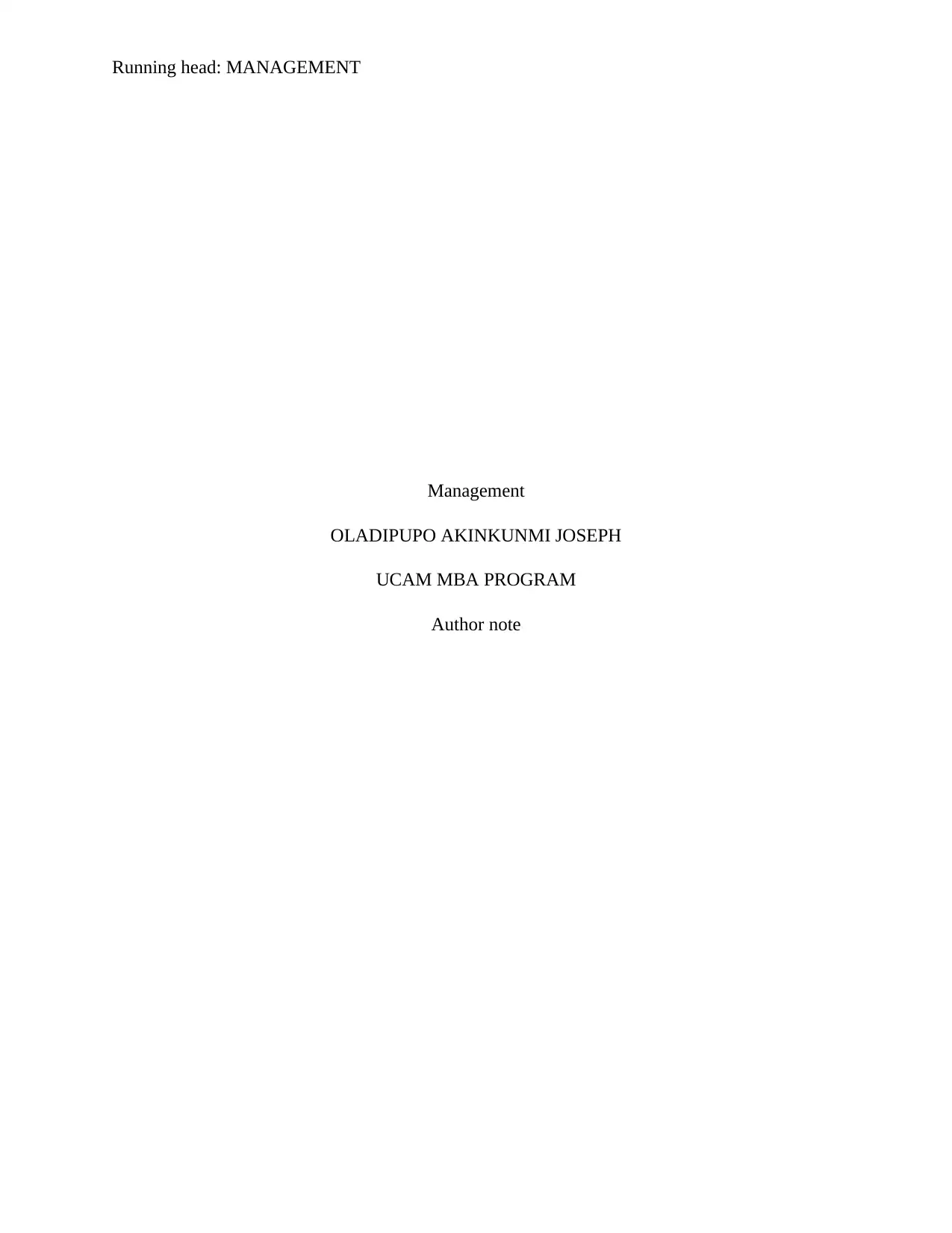
Running head: MANAGEMENT
Management
OLADIPUPO AKINKUNMI JOSEPH
UCAM MBA PROGRAM
Author note
Management
OLADIPUPO AKINKUNMI JOSEPH
UCAM MBA PROGRAM
Author note
Paraphrase This Document
Need a fresh take? Get an instant paraphrase of this document with our AI Paraphraser
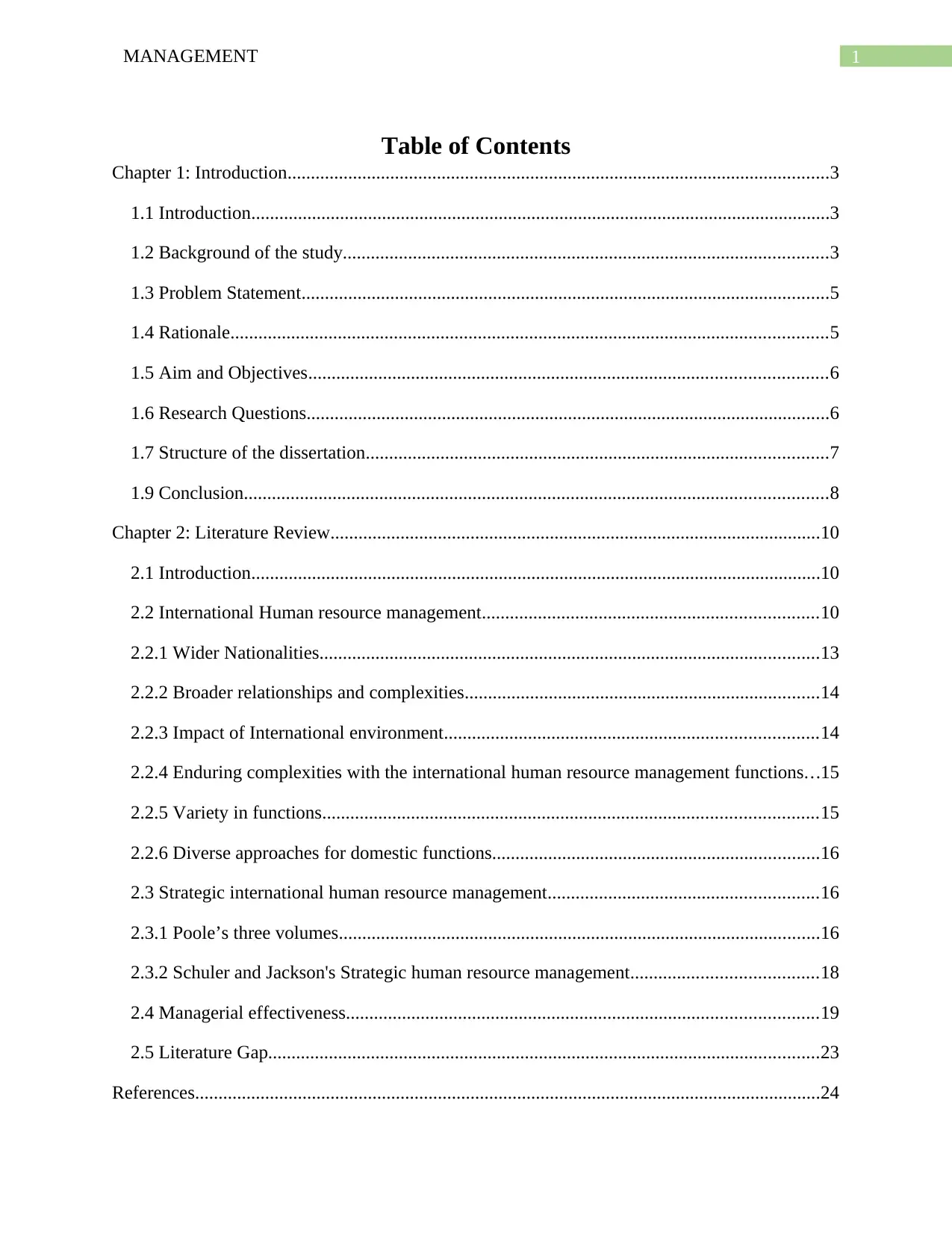
1MANAGEMENT
Table of Contents
Chapter 1: Introduction....................................................................................................................3
1.1 Introduction............................................................................................................................3
1.2 Background of the study........................................................................................................3
1.3 Problem Statement.................................................................................................................5
1.4 Rationale................................................................................................................................5
1.5 Aim and Objectives...............................................................................................................6
1.6 Research Questions................................................................................................................6
1.7 Structure of the dissertation...................................................................................................7
1.9 Conclusion.............................................................................................................................8
Chapter 2: Literature Review.........................................................................................................10
2.1 Introduction..........................................................................................................................10
2.2 International Human resource management........................................................................10
2.2.1 Wider Nationalities...........................................................................................................13
2.2.2 Broader relationships and complexities............................................................................14
2.2.3 Impact of International environment................................................................................14
2.2.4 Enduring complexities with the international human resource management functions...15
2.2.5 Variety in functions..........................................................................................................15
2.2.6 Diverse approaches for domestic functions......................................................................16
2.3 Strategic international human resource management..........................................................16
2.3.1 Poole’s three volumes.......................................................................................................16
2.3.2 Schuler and Jackson's Strategic human resource management........................................18
2.4 Managerial effectiveness.....................................................................................................19
2.5 Literature Gap......................................................................................................................23
References......................................................................................................................................24
Table of Contents
Chapter 1: Introduction....................................................................................................................3
1.1 Introduction............................................................................................................................3
1.2 Background of the study........................................................................................................3
1.3 Problem Statement.................................................................................................................5
1.4 Rationale................................................................................................................................5
1.5 Aim and Objectives...............................................................................................................6
1.6 Research Questions................................................................................................................6
1.7 Structure of the dissertation...................................................................................................7
1.9 Conclusion.............................................................................................................................8
Chapter 2: Literature Review.........................................................................................................10
2.1 Introduction..........................................................................................................................10
2.2 International Human resource management........................................................................10
2.2.1 Wider Nationalities...........................................................................................................13
2.2.2 Broader relationships and complexities............................................................................14
2.2.3 Impact of International environment................................................................................14
2.2.4 Enduring complexities with the international human resource management functions...15
2.2.5 Variety in functions..........................................................................................................15
2.2.6 Diverse approaches for domestic functions......................................................................16
2.3 Strategic international human resource management..........................................................16
2.3.1 Poole’s three volumes.......................................................................................................16
2.3.2 Schuler and Jackson's Strategic human resource management........................................18
2.4 Managerial effectiveness.....................................................................................................19
2.5 Literature Gap......................................................................................................................23
References......................................................................................................................................24

2MANAGEMENT
⊘ This is a preview!⊘
Do you want full access?
Subscribe today to unlock all pages.

Trusted by 1+ million students worldwide
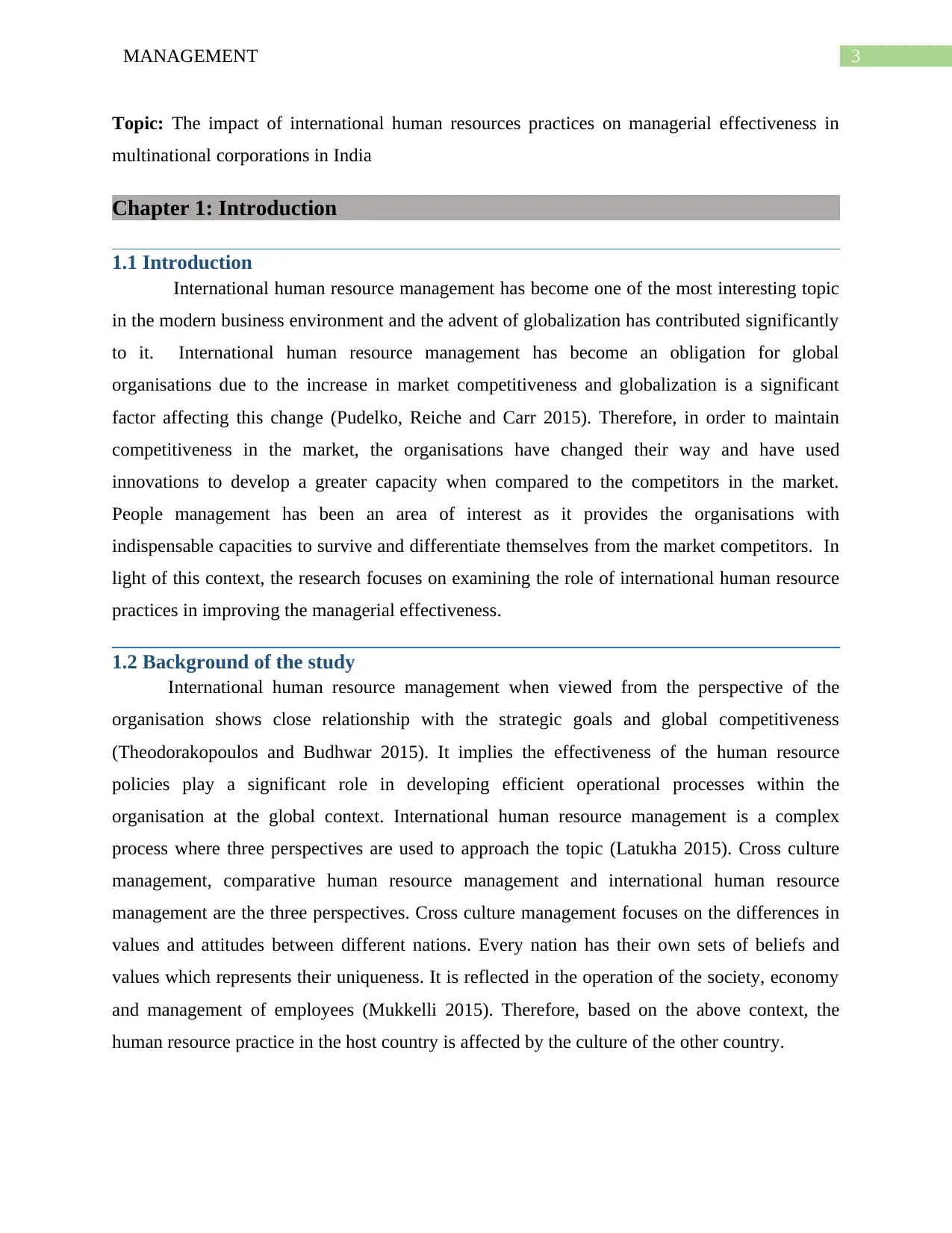
3MANAGEMENT
Topic: The impact of international human resources practices on managerial effectiveness in
multinational corporations in India
Chapter 1: Introduction
1.1 Introduction
International human resource management has become one of the most interesting topic
in the modern business environment and the advent of globalization has contributed significantly
to it. International human resource management has become an obligation for global
organisations due to the increase in market competitiveness and globalization is a significant
factor affecting this change (Pudelko, Reiche and Carr 2015). Therefore, in order to maintain
competitiveness in the market, the organisations have changed their way and have used
innovations to develop a greater capacity when compared to the competitors in the market.
People management has been an area of interest as it provides the organisations with
indispensable capacities to survive and differentiate themselves from the market competitors. In
light of this context, the research focuses on examining the role of international human resource
practices in improving the managerial effectiveness.
1.2 Background of the study
International human resource management when viewed from the perspective of the
organisation shows close relationship with the strategic goals and global competitiveness
(Theodorakopoulos and Budhwar 2015). It implies the effectiveness of the human resource
policies play a significant role in developing efficient operational processes within the
organisation at the global context. International human resource management is a complex
process where three perspectives are used to approach the topic (Latukha 2015). Cross culture
management, comparative human resource management and international human resource
management are the three perspectives. Cross culture management focuses on the differences in
values and attitudes between different nations. Every nation has their own sets of beliefs and
values which represents their uniqueness. It is reflected in the operation of the society, economy
and management of employees (Mukkelli 2015). Therefore, based on the above context, the
human resource practice in the host country is affected by the culture of the other country.
Topic: The impact of international human resources practices on managerial effectiveness in
multinational corporations in India
Chapter 1: Introduction
1.1 Introduction
International human resource management has become one of the most interesting topic
in the modern business environment and the advent of globalization has contributed significantly
to it. International human resource management has become an obligation for global
organisations due to the increase in market competitiveness and globalization is a significant
factor affecting this change (Pudelko, Reiche and Carr 2015). Therefore, in order to maintain
competitiveness in the market, the organisations have changed their way and have used
innovations to develop a greater capacity when compared to the competitors in the market.
People management has been an area of interest as it provides the organisations with
indispensable capacities to survive and differentiate themselves from the market competitors. In
light of this context, the research focuses on examining the role of international human resource
practices in improving the managerial effectiveness.
1.2 Background of the study
International human resource management when viewed from the perspective of the
organisation shows close relationship with the strategic goals and global competitiveness
(Theodorakopoulos and Budhwar 2015). It implies the effectiveness of the human resource
policies play a significant role in developing efficient operational processes within the
organisation at the global context. International human resource management is a complex
process where three perspectives are used to approach the topic (Latukha 2015). Cross culture
management, comparative human resource management and international human resource
management are the three perspectives. Cross culture management focuses on the differences in
values and attitudes between different nations. Every nation has their own sets of beliefs and
values which represents their uniqueness. It is reflected in the operation of the society, economy
and management of employees (Mukkelli 2015). Therefore, based on the above context, the
human resource practice in the host country is affected by the culture of the other country.
Paraphrase This Document
Need a fresh take? Get an instant paraphrase of this document with our AI Paraphraser
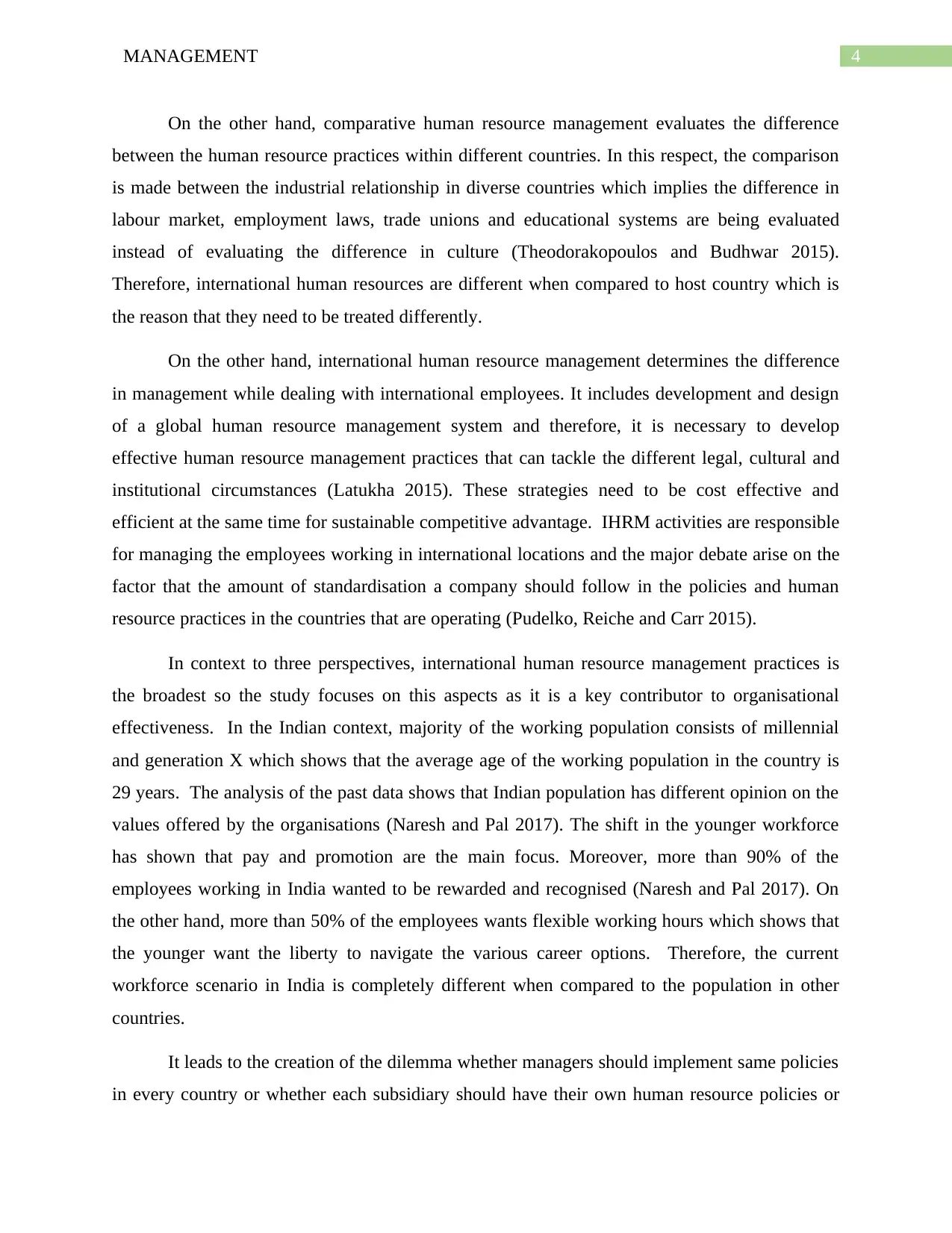
4MANAGEMENT
On the other hand, comparative human resource management evaluates the difference
between the human resource practices within different countries. In this respect, the comparison
is made between the industrial relationship in diverse countries which implies the difference in
labour market, employment laws, trade unions and educational systems are being evaluated
instead of evaluating the difference in culture (Theodorakopoulos and Budhwar 2015).
Therefore, international human resources are different when compared to host country which is
the reason that they need to be treated differently.
On the other hand, international human resource management determines the difference
in management while dealing with international employees. It includes development and design
of a global human resource management system and therefore, it is necessary to develop
effective human resource management practices that can tackle the different legal, cultural and
institutional circumstances (Latukha 2015). These strategies need to be cost effective and
efficient at the same time for sustainable competitive advantage. IHRM activities are responsible
for managing the employees working in international locations and the major debate arise on the
factor that the amount of standardisation a company should follow in the policies and human
resource practices in the countries that are operating (Pudelko, Reiche and Carr 2015).
In context to three perspectives, international human resource management practices is
the broadest so the study focuses on this aspects as it is a key contributor to organisational
effectiveness. In the Indian context, majority of the working population consists of millennial
and generation X which shows that the average age of the working population in the country is
29 years. The analysis of the past data shows that Indian population has different opinion on the
values offered by the organisations (Naresh and Pal 2017). The shift in the younger workforce
has shown that pay and promotion are the main focus. Moreover, more than 90% of the
employees working in India wanted to be rewarded and recognised (Naresh and Pal 2017). On
the other hand, more than 50% of the employees wants flexible working hours which shows that
the younger want the liberty to navigate the various career options. Therefore, the current
workforce scenario in India is completely different when compared to the population in other
countries.
It leads to the creation of the dilemma whether managers should implement same policies
in every country or whether each subsidiary should have their own human resource policies or
On the other hand, comparative human resource management evaluates the difference
between the human resource practices within different countries. In this respect, the comparison
is made between the industrial relationship in diverse countries which implies the difference in
labour market, employment laws, trade unions and educational systems are being evaluated
instead of evaluating the difference in culture (Theodorakopoulos and Budhwar 2015).
Therefore, international human resources are different when compared to host country which is
the reason that they need to be treated differently.
On the other hand, international human resource management determines the difference
in management while dealing with international employees. It includes development and design
of a global human resource management system and therefore, it is necessary to develop
effective human resource management practices that can tackle the different legal, cultural and
institutional circumstances (Latukha 2015). These strategies need to be cost effective and
efficient at the same time for sustainable competitive advantage. IHRM activities are responsible
for managing the employees working in international locations and the major debate arise on the
factor that the amount of standardisation a company should follow in the policies and human
resource practices in the countries that are operating (Pudelko, Reiche and Carr 2015).
In context to three perspectives, international human resource management practices is
the broadest so the study focuses on this aspects as it is a key contributor to organisational
effectiveness. In the Indian context, majority of the working population consists of millennial
and generation X which shows that the average age of the working population in the country is
29 years. The analysis of the past data shows that Indian population has different opinion on the
values offered by the organisations (Naresh and Pal 2017). The shift in the younger workforce
has shown that pay and promotion are the main focus. Moreover, more than 90% of the
employees working in India wanted to be rewarded and recognised (Naresh and Pal 2017). On
the other hand, more than 50% of the employees wants flexible working hours which shows that
the younger want the liberty to navigate the various career options. Therefore, the current
workforce scenario in India is completely different when compared to the population in other
countries.
It leads to the creation of the dilemma whether managers should implement same policies
in every country or whether each subsidiary should have their own human resource policies or
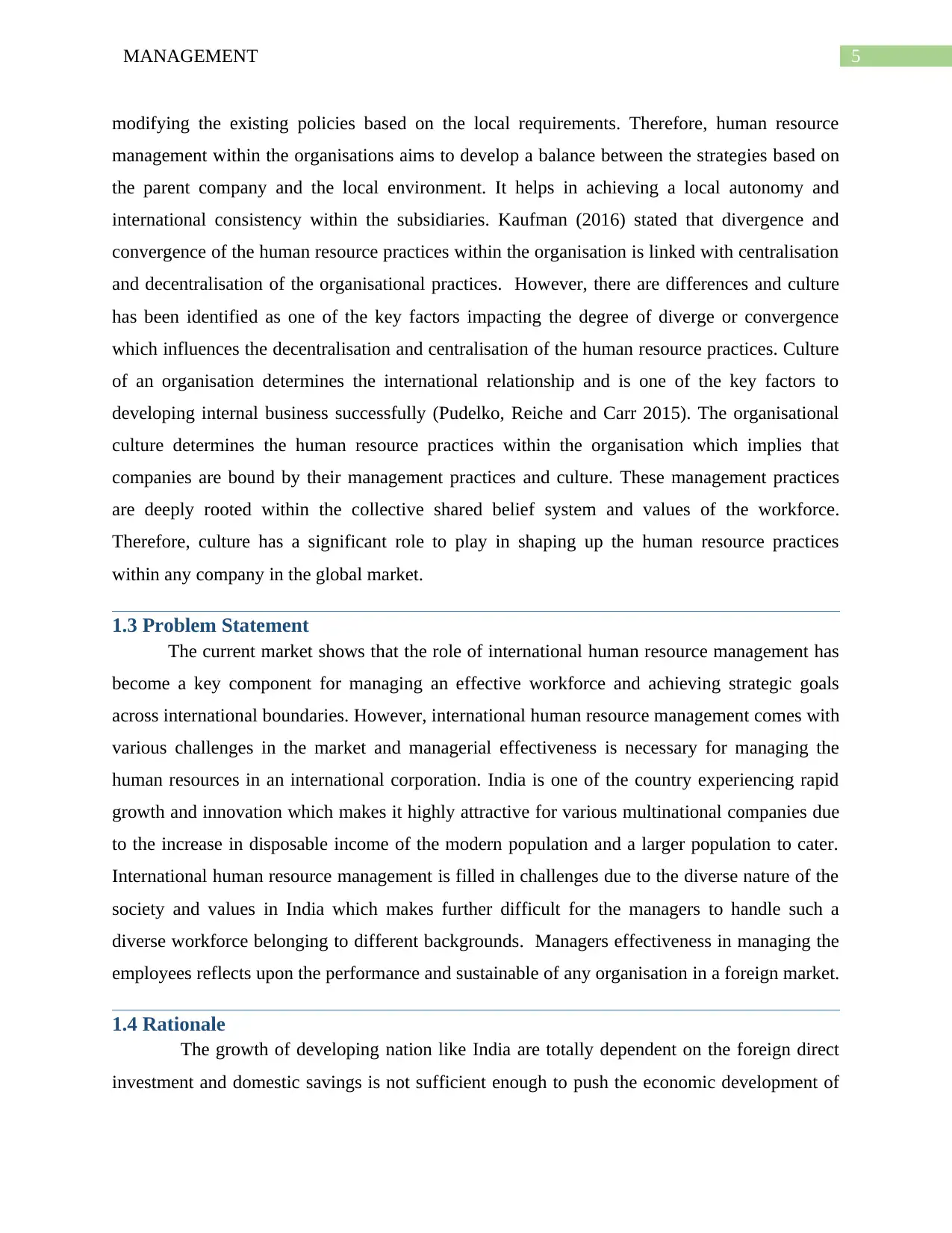
5MANAGEMENT
modifying the existing policies based on the local requirements. Therefore, human resource
management within the organisations aims to develop a balance between the strategies based on
the parent company and the local environment. It helps in achieving a local autonomy and
international consistency within the subsidiaries. Kaufman (2016) stated that divergence and
convergence of the human resource practices within the organisation is linked with centralisation
and decentralisation of the organisational practices. However, there are differences and culture
has been identified as one of the key factors impacting the degree of diverge or convergence
which influences the decentralisation and centralisation of the human resource practices. Culture
of an organisation determines the international relationship and is one of the key factors to
developing internal business successfully (Pudelko, Reiche and Carr 2015). The organisational
culture determines the human resource practices within the organisation which implies that
companies are bound by their management practices and culture. These management practices
are deeply rooted within the collective shared belief system and values of the workforce.
Therefore, culture has a significant role to play in shaping up the human resource practices
within any company in the global market.
1.3 Problem Statement
The current market shows that the role of international human resource management has
become a key component for managing an effective workforce and achieving strategic goals
across international boundaries. However, international human resource management comes with
various challenges in the market and managerial effectiveness is necessary for managing the
human resources in an international corporation. India is one of the country experiencing rapid
growth and innovation which makes it highly attractive for various multinational companies due
to the increase in disposable income of the modern population and a larger population to cater.
International human resource management is filled in challenges due to the diverse nature of the
society and values in India which makes further difficult for the managers to handle such a
diverse workforce belonging to different backgrounds. Managers effectiveness in managing the
employees reflects upon the performance and sustainable of any organisation in a foreign market.
1.4 Rationale
The growth of developing nation like India are totally dependent on the foreign direct
investment and domestic savings is not sufficient enough to push the economic development of
modifying the existing policies based on the local requirements. Therefore, human resource
management within the organisations aims to develop a balance between the strategies based on
the parent company and the local environment. It helps in achieving a local autonomy and
international consistency within the subsidiaries. Kaufman (2016) stated that divergence and
convergence of the human resource practices within the organisation is linked with centralisation
and decentralisation of the organisational practices. However, there are differences and culture
has been identified as one of the key factors impacting the degree of diverge or convergence
which influences the decentralisation and centralisation of the human resource practices. Culture
of an organisation determines the international relationship and is one of the key factors to
developing internal business successfully (Pudelko, Reiche and Carr 2015). The organisational
culture determines the human resource practices within the organisation which implies that
companies are bound by their management practices and culture. These management practices
are deeply rooted within the collective shared belief system and values of the workforce.
Therefore, culture has a significant role to play in shaping up the human resource practices
within any company in the global market.
1.3 Problem Statement
The current market shows that the role of international human resource management has
become a key component for managing an effective workforce and achieving strategic goals
across international boundaries. However, international human resource management comes with
various challenges in the market and managerial effectiveness is necessary for managing the
human resources in an international corporation. India is one of the country experiencing rapid
growth and innovation which makes it highly attractive for various multinational companies due
to the increase in disposable income of the modern population and a larger population to cater.
International human resource management is filled in challenges due to the diverse nature of the
society and values in India which makes further difficult for the managers to handle such a
diverse workforce belonging to different backgrounds. Managers effectiveness in managing the
employees reflects upon the performance and sustainable of any organisation in a foreign market.
1.4 Rationale
The growth of developing nation like India are totally dependent on the foreign direct
investment and domestic savings is not sufficient enough to push the economic development of
⊘ This is a preview!⊘
Do you want full access?
Subscribe today to unlock all pages.

Trusted by 1+ million students worldwide
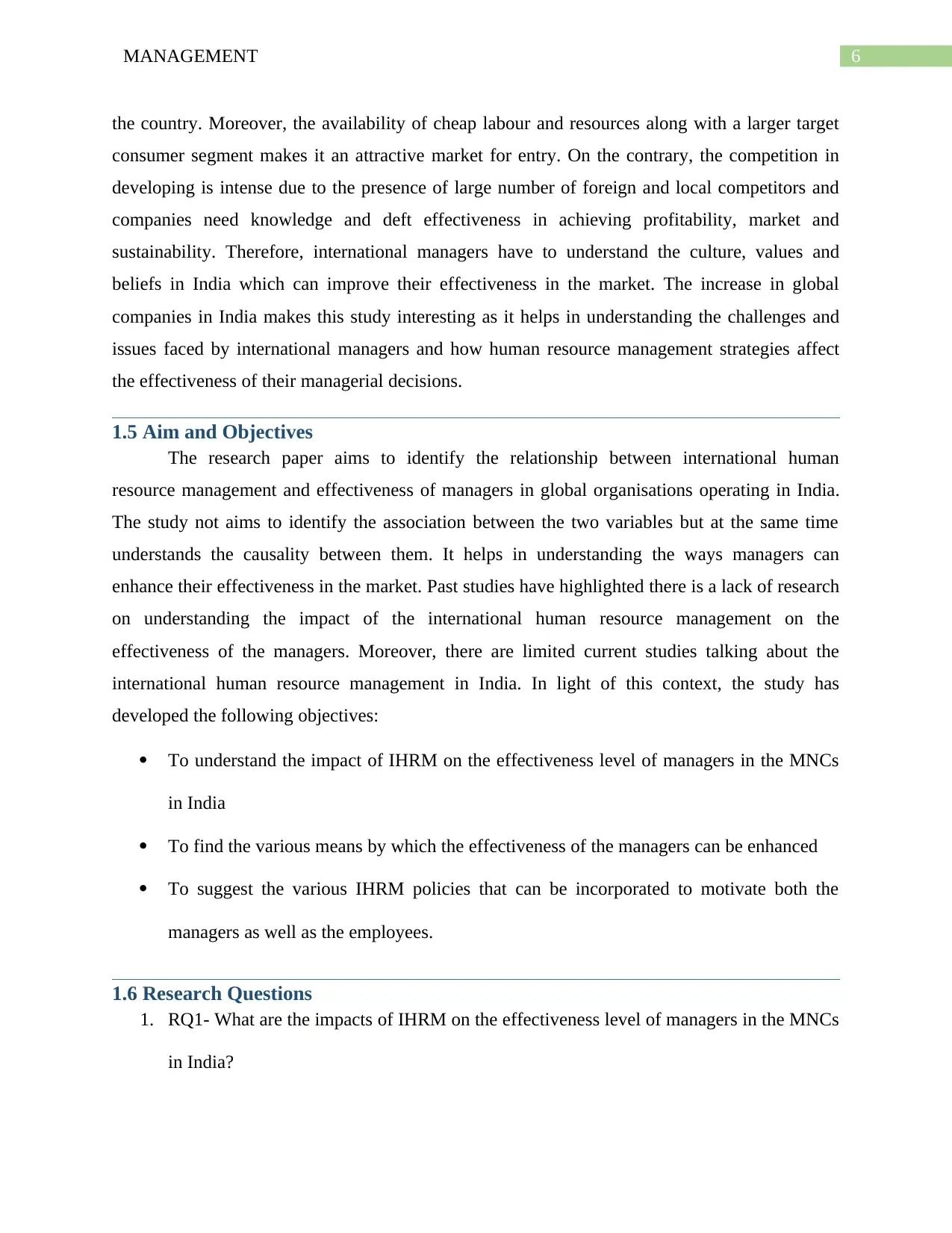
6MANAGEMENT
the country. Moreover, the availability of cheap labour and resources along with a larger target
consumer segment makes it an attractive market for entry. On the contrary, the competition in
developing is intense due to the presence of large number of foreign and local competitors and
companies need knowledge and deft effectiveness in achieving profitability, market and
sustainability. Therefore, international managers have to understand the culture, values and
beliefs in India which can improve their effectiveness in the market. The increase in global
companies in India makes this study interesting as it helps in understanding the challenges and
issues faced by international managers and how human resource management strategies affect
the effectiveness of their managerial decisions.
1.5 Aim and Objectives
The research paper aims to identify the relationship between international human
resource management and effectiveness of managers in global organisations operating in India.
The study not aims to identify the association between the two variables but at the same time
understands the causality between them. It helps in understanding the ways managers can
enhance their effectiveness in the market. Past studies have highlighted there is a lack of research
on understanding the impact of the international human resource management on the
effectiveness of the managers. Moreover, there are limited current studies talking about the
international human resource management in India. In light of this context, the study has
developed the following objectives:
To understand the impact of IHRM on the effectiveness level of managers in the MNCs
in India
To find the various means by which the effectiveness of the managers can be enhanced
To suggest the various IHRM policies that can be incorporated to motivate both the
managers as well as the employees.
1.6 Research Questions
1. RQ1- What are the impacts of IHRM on the effectiveness level of managers in the MNCs
in India?
the country. Moreover, the availability of cheap labour and resources along with a larger target
consumer segment makes it an attractive market for entry. On the contrary, the competition in
developing is intense due to the presence of large number of foreign and local competitors and
companies need knowledge and deft effectiveness in achieving profitability, market and
sustainability. Therefore, international managers have to understand the culture, values and
beliefs in India which can improve their effectiveness in the market. The increase in global
companies in India makes this study interesting as it helps in understanding the challenges and
issues faced by international managers and how human resource management strategies affect
the effectiveness of their managerial decisions.
1.5 Aim and Objectives
The research paper aims to identify the relationship between international human
resource management and effectiveness of managers in global organisations operating in India.
The study not aims to identify the association between the two variables but at the same time
understands the causality between them. It helps in understanding the ways managers can
enhance their effectiveness in the market. Past studies have highlighted there is a lack of research
on understanding the impact of the international human resource management on the
effectiveness of the managers. Moreover, there are limited current studies talking about the
international human resource management in India. In light of this context, the study has
developed the following objectives:
To understand the impact of IHRM on the effectiveness level of managers in the MNCs
in India
To find the various means by which the effectiveness of the managers can be enhanced
To suggest the various IHRM policies that can be incorporated to motivate both the
managers as well as the employees.
1.6 Research Questions
1. RQ1- What are the impacts of IHRM on the effectiveness level of managers in the MNCs
in India?
Paraphrase This Document
Need a fresh take? Get an instant paraphrase of this document with our AI Paraphraser
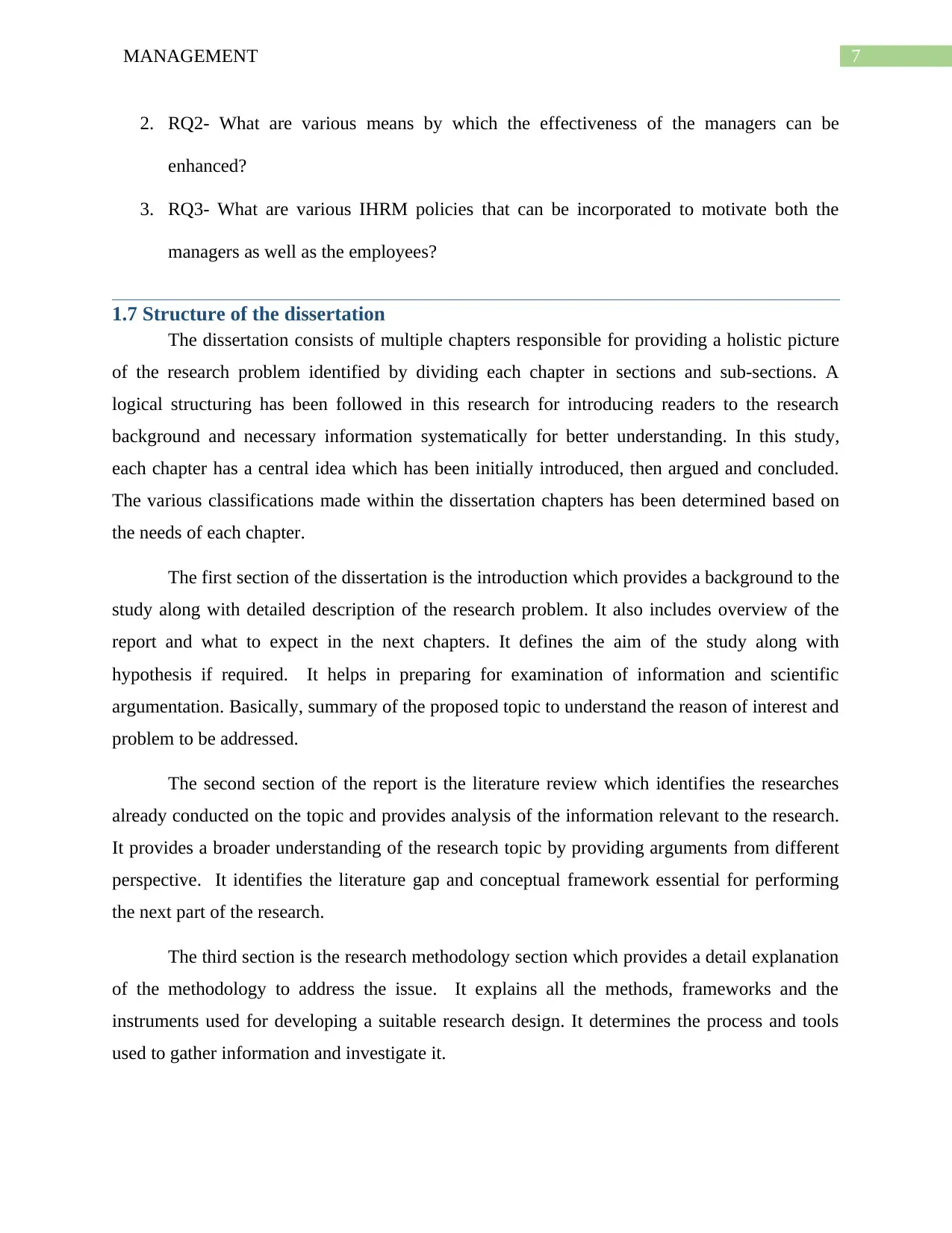
7MANAGEMENT
2. RQ2- What are various means by which the effectiveness of the managers can be
enhanced?
3. RQ3- What are various IHRM policies that can be incorporated to motivate both the
managers as well as the employees?
1.7 Structure of the dissertation
The dissertation consists of multiple chapters responsible for providing a holistic picture
of the research problem identified by dividing each chapter in sections and sub-sections. A
logical structuring has been followed in this research for introducing readers to the research
background and necessary information systematically for better understanding. In this study,
each chapter has a central idea which has been initially introduced, then argued and concluded.
The various classifications made within the dissertation chapters has been determined based on
the needs of each chapter.
The first section of the dissertation is the introduction which provides a background to the
study along with detailed description of the research problem. It also includes overview of the
report and what to expect in the next chapters. It defines the aim of the study along with
hypothesis if required. It helps in preparing for examination of information and scientific
argumentation. Basically, summary of the proposed topic to understand the reason of interest and
problem to be addressed.
The second section of the report is the literature review which identifies the researches
already conducted on the topic and provides analysis of the information relevant to the research.
It provides a broader understanding of the research topic by providing arguments from different
perspective. It identifies the literature gap and conceptual framework essential for performing
the next part of the research.
The third section is the research methodology section which provides a detail explanation
of the methodology to address the issue. It explains all the methods, frameworks and the
instruments used for developing a suitable research design. It determines the process and tools
used to gather information and investigate it.
2. RQ2- What are various means by which the effectiveness of the managers can be
enhanced?
3. RQ3- What are various IHRM policies that can be incorporated to motivate both the
managers as well as the employees?
1.7 Structure of the dissertation
The dissertation consists of multiple chapters responsible for providing a holistic picture
of the research problem identified by dividing each chapter in sections and sub-sections. A
logical structuring has been followed in this research for introducing readers to the research
background and necessary information systematically for better understanding. In this study,
each chapter has a central idea which has been initially introduced, then argued and concluded.
The various classifications made within the dissertation chapters has been determined based on
the needs of each chapter.
The first section of the dissertation is the introduction which provides a background to the
study along with detailed description of the research problem. It also includes overview of the
report and what to expect in the next chapters. It defines the aim of the study along with
hypothesis if required. It helps in preparing for examination of information and scientific
argumentation. Basically, summary of the proposed topic to understand the reason of interest and
problem to be addressed.
The second section of the report is the literature review which identifies the researches
already conducted on the topic and provides analysis of the information relevant to the research.
It provides a broader understanding of the research topic by providing arguments from different
perspective. It identifies the literature gap and conceptual framework essential for performing
the next part of the research.
The third section is the research methodology section which provides a detail explanation
of the methodology to address the issue. It explains all the methods, frameworks and the
instruments used for developing a suitable research design. It determines the process and tools
used to gather information and investigate it.
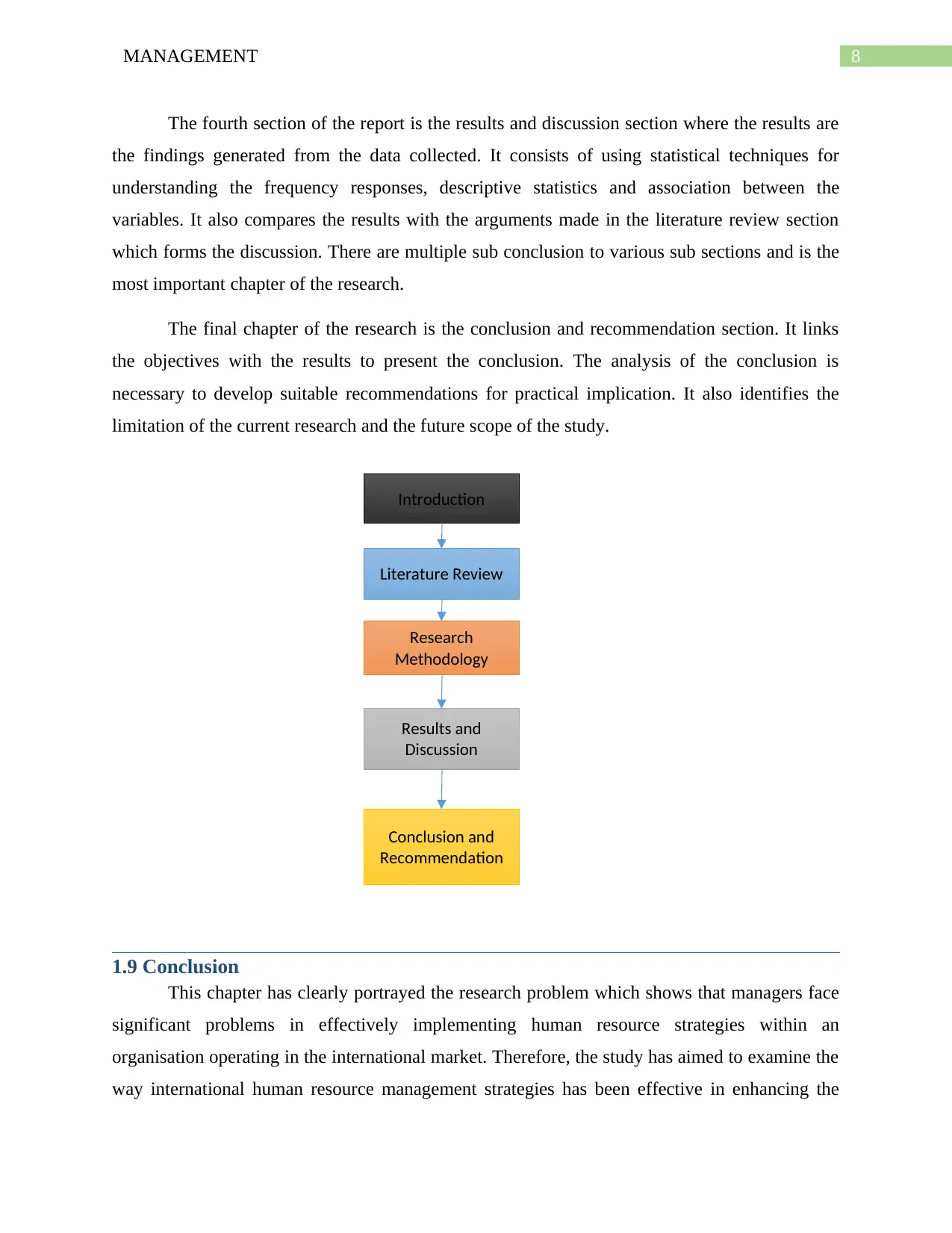
8MANAGEMENT
Introduction
Conclusion and
Recommendation
Results and
Discussion
Research
Methodology
Literature Review
The fourth section of the report is the results and discussion section where the results are
the findings generated from the data collected. It consists of using statistical techniques for
understanding the frequency responses, descriptive statistics and association between the
variables. It also compares the results with the arguments made in the literature review section
which forms the discussion. There are multiple sub conclusion to various sub sections and is the
most important chapter of the research.
The final chapter of the research is the conclusion and recommendation section. It links
the objectives with the results to present the conclusion. The analysis of the conclusion is
necessary to develop suitable recommendations for practical implication. It also identifies the
limitation of the current research and the future scope of the study.
1.9 Conclusion
This chapter has clearly portrayed the research problem which shows that managers face
significant problems in effectively implementing human resource strategies within an
organisation operating in the international market. Therefore, the study has aimed to examine the
way international human resource management strategies has been effective in enhancing the
Introduction
Conclusion and
Recommendation
Results and
Discussion
Research
Methodology
Literature Review
The fourth section of the report is the results and discussion section where the results are
the findings generated from the data collected. It consists of using statistical techniques for
understanding the frequency responses, descriptive statistics and association between the
variables. It also compares the results with the arguments made in the literature review section
which forms the discussion. There are multiple sub conclusion to various sub sections and is the
most important chapter of the research.
The final chapter of the research is the conclusion and recommendation section. It links
the objectives with the results to present the conclusion. The analysis of the conclusion is
necessary to develop suitable recommendations for practical implication. It also identifies the
limitation of the current research and the future scope of the study.
1.9 Conclusion
This chapter has clearly portrayed the research problem which shows that managers face
significant problems in effectively implementing human resource strategies within an
organisation operating in the international market. Therefore, the study has aimed to examine the
way international human resource management strategies has been effective in enhancing the
⊘ This is a preview!⊘
Do you want full access?
Subscribe today to unlock all pages.

Trusted by 1+ million students worldwide
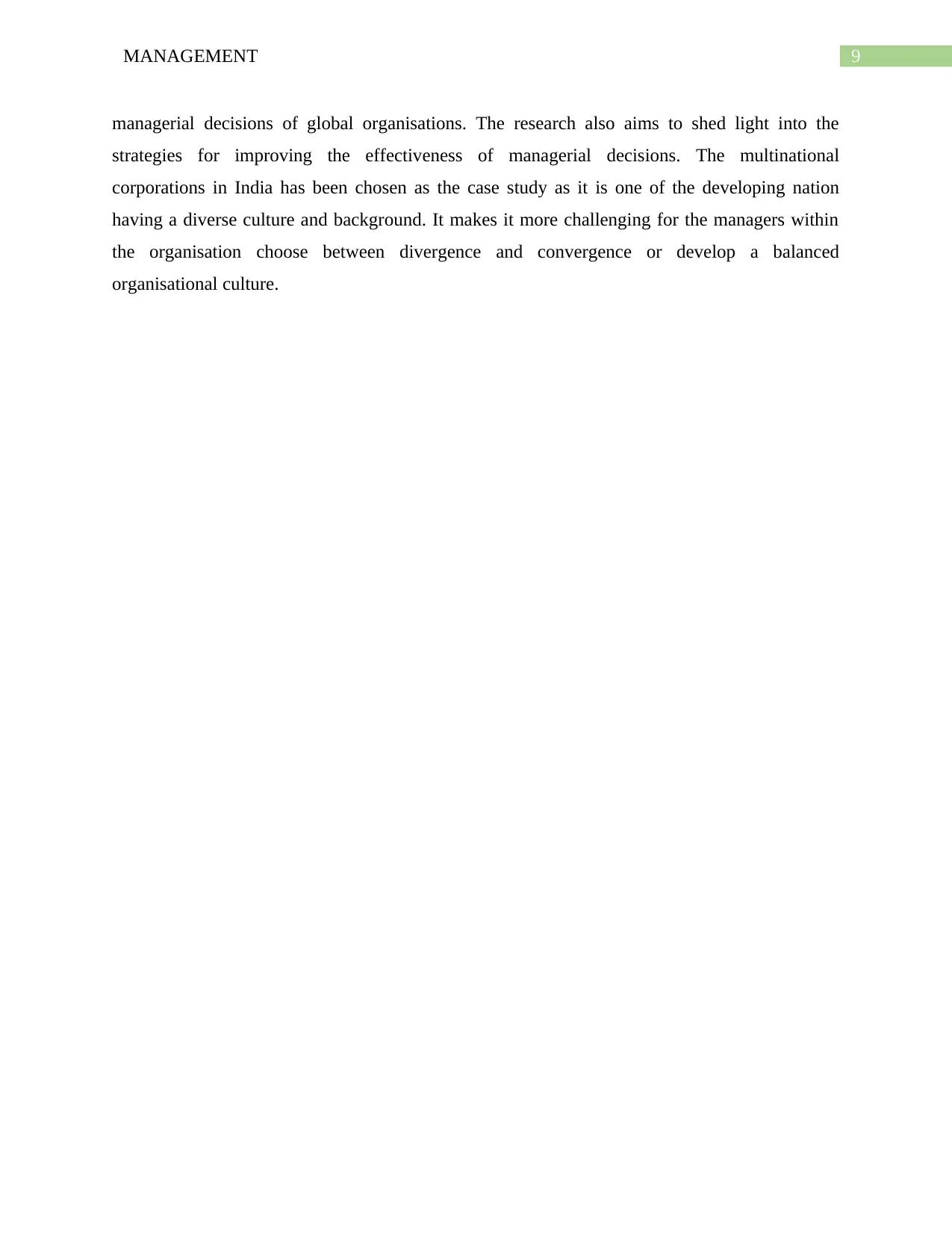
9MANAGEMENT
managerial decisions of global organisations. The research also aims to shed light into the
strategies for improving the effectiveness of managerial decisions. The multinational
corporations in India has been chosen as the case study as it is one of the developing nation
having a diverse culture and background. It makes it more challenging for the managers within
the organisation choose between divergence and convergence or develop a balanced
organisational culture.
managerial decisions of global organisations. The research also aims to shed light into the
strategies for improving the effectiveness of managerial decisions. The multinational
corporations in India has been chosen as the case study as it is one of the developing nation
having a diverse culture and background. It makes it more challenging for the managers within
the organisation choose between divergence and convergence or develop a balanced
organisational culture.
Paraphrase This Document
Need a fresh take? Get an instant paraphrase of this document with our AI Paraphraser
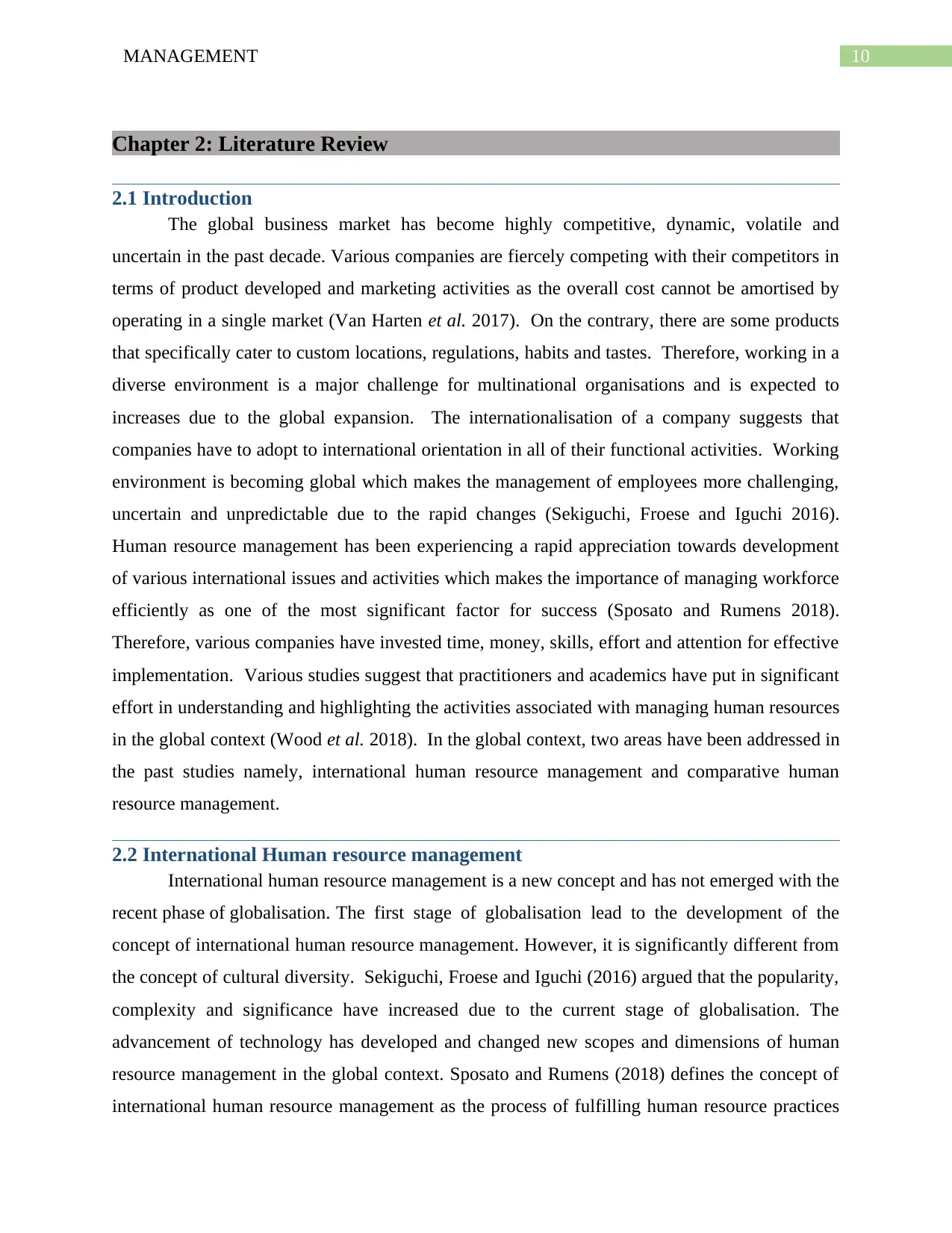
10MANAGEMENT
Chapter 2: Literature Review
2.1 Introduction
The global business market has become highly competitive, dynamic, volatile and
uncertain in the past decade. Various companies are fiercely competing with their competitors in
terms of product developed and marketing activities as the overall cost cannot be amortised by
operating in a single market (Van Harten et al. 2017). On the contrary, there are some products
that specifically cater to custom locations, regulations, habits and tastes. Therefore, working in a
diverse environment is a major challenge for multinational organisations and is expected to
increases due to the global expansion. The internationalisation of a company suggests that
companies have to adopt to international orientation in all of their functional activities. Working
environment is becoming global which makes the management of employees more challenging,
uncertain and unpredictable due to the rapid changes (Sekiguchi, Froese and Iguchi 2016).
Human resource management has been experiencing a rapid appreciation towards development
of various international issues and activities which makes the importance of managing workforce
efficiently as one of the most significant factor for success (Sposato and Rumens 2018).
Therefore, various companies have invested time, money, skills, effort and attention for effective
implementation. Various studies suggest that practitioners and academics have put in significant
effort in understanding and highlighting the activities associated with managing human resources
in the global context (Wood et al. 2018). In the global context, two areas have been addressed in
the past studies namely, international human resource management and comparative human
resource management.
2.2 International Human resource management
International human resource management is a new concept and has not emerged with the
recent phase of globalisation. The first stage of globalisation lead to the development of the
concept of international human resource management. However, it is significantly different from
the concept of cultural diversity. Sekiguchi, Froese and Iguchi (2016) argued that the popularity,
complexity and significance have increased due to the current stage of globalisation. The
advancement of technology has developed and changed new scopes and dimensions of human
resource management in the global context. Sposato and Rumens (2018) defines the concept of
international human resource management as the process of fulfilling human resource practices
Chapter 2: Literature Review
2.1 Introduction
The global business market has become highly competitive, dynamic, volatile and
uncertain in the past decade. Various companies are fiercely competing with their competitors in
terms of product developed and marketing activities as the overall cost cannot be amortised by
operating in a single market (Van Harten et al. 2017). On the contrary, there are some products
that specifically cater to custom locations, regulations, habits and tastes. Therefore, working in a
diverse environment is a major challenge for multinational organisations and is expected to
increases due to the global expansion. The internationalisation of a company suggests that
companies have to adopt to international orientation in all of their functional activities. Working
environment is becoming global which makes the management of employees more challenging,
uncertain and unpredictable due to the rapid changes (Sekiguchi, Froese and Iguchi 2016).
Human resource management has been experiencing a rapid appreciation towards development
of various international issues and activities which makes the importance of managing workforce
efficiently as one of the most significant factor for success (Sposato and Rumens 2018).
Therefore, various companies have invested time, money, skills, effort and attention for effective
implementation. Various studies suggest that practitioners and academics have put in significant
effort in understanding and highlighting the activities associated with managing human resources
in the global context (Wood et al. 2018). In the global context, two areas have been addressed in
the past studies namely, international human resource management and comparative human
resource management.
2.2 International Human resource management
International human resource management is a new concept and has not emerged with the
recent phase of globalisation. The first stage of globalisation lead to the development of the
concept of international human resource management. However, it is significantly different from
the concept of cultural diversity. Sekiguchi, Froese and Iguchi (2016) argued that the popularity,
complexity and significance have increased due to the current stage of globalisation. The
advancement of technology has developed and changed new scopes and dimensions of human
resource management in the global context. Sposato and Rumens (2018) defines the concept of
international human resource management as the process of fulfilling human resource practices
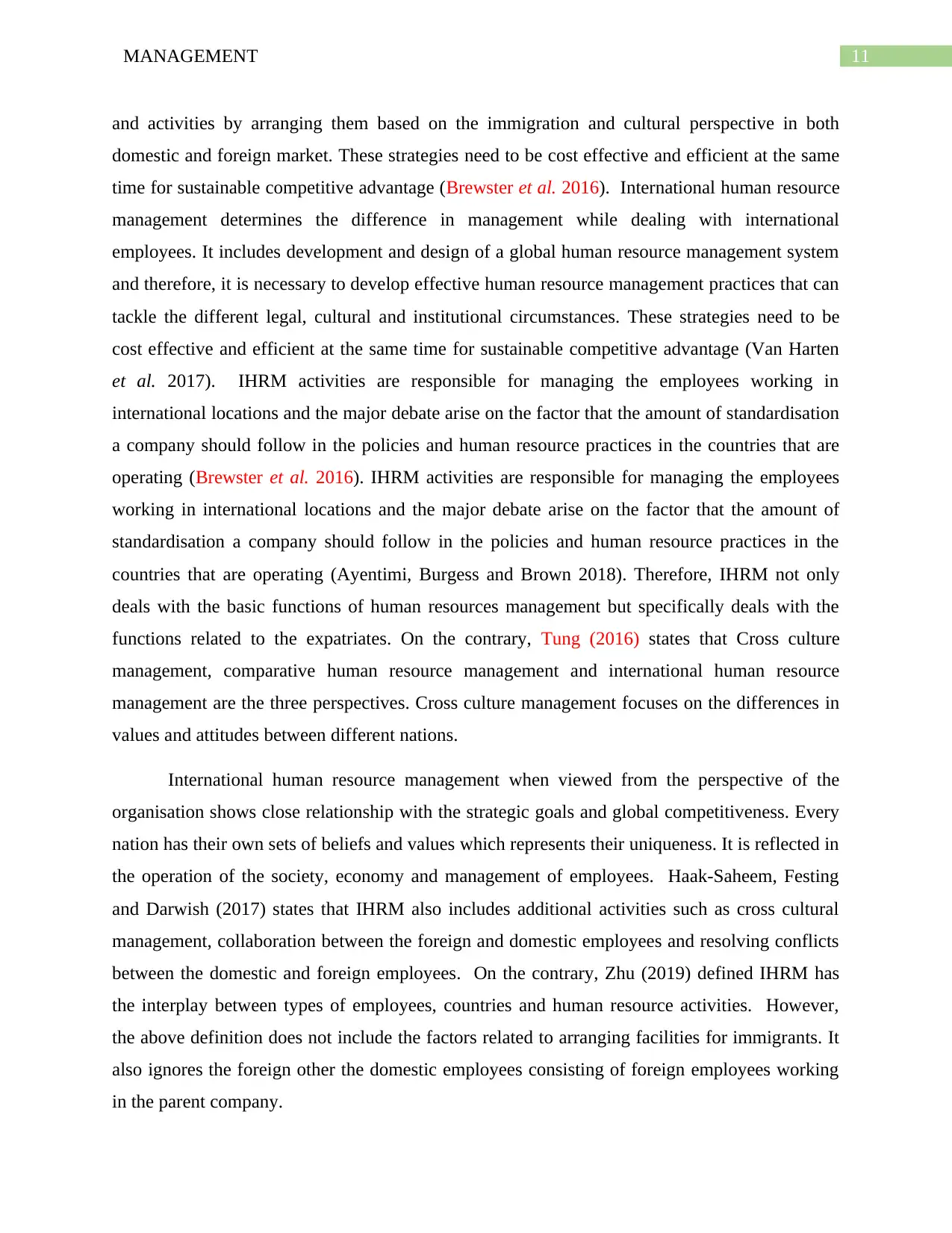
11MANAGEMENT
and activities by arranging them based on the immigration and cultural perspective in both
domestic and foreign market. These strategies need to be cost effective and efficient at the same
time for sustainable competitive advantage (Brewster et al. 2016). International human resource
management determines the difference in management while dealing with international
employees. It includes development and design of a global human resource management system
and therefore, it is necessary to develop effective human resource management practices that can
tackle the different legal, cultural and institutional circumstances. These strategies need to be
cost effective and efficient at the same time for sustainable competitive advantage (Van Harten
et al. 2017). IHRM activities are responsible for managing the employees working in
international locations and the major debate arise on the factor that the amount of standardisation
a company should follow in the policies and human resource practices in the countries that are
operating (Brewster et al. 2016). IHRM activities are responsible for managing the employees
working in international locations and the major debate arise on the factor that the amount of
standardisation a company should follow in the policies and human resource practices in the
countries that are operating (Ayentimi, Burgess and Brown 2018). Therefore, IHRM not only
deals with the basic functions of human resources management but specifically deals with the
functions related to the expatriates. On the contrary, Tung (2016) states that Cross culture
management, comparative human resource management and international human resource
management are the three perspectives. Cross culture management focuses on the differences in
values and attitudes between different nations.
International human resource management when viewed from the perspective of the
organisation shows close relationship with the strategic goals and global competitiveness. Every
nation has their own sets of beliefs and values which represents their uniqueness. It is reflected in
the operation of the society, economy and management of employees. Haak-Saheem, Festing
and Darwish (2017) states that IHRM also includes additional activities such as cross cultural
management, collaboration between the foreign and domestic employees and resolving conflicts
between the domestic and foreign employees. On the contrary, Zhu (2019) defined IHRM has
the interplay between types of employees, countries and human resource activities. However,
the above definition does not include the factors related to arranging facilities for immigrants. It
also ignores the foreign other the domestic employees consisting of foreign employees working
in the parent company.
and activities by arranging them based on the immigration and cultural perspective in both
domestic and foreign market. These strategies need to be cost effective and efficient at the same
time for sustainable competitive advantage (Brewster et al. 2016). International human resource
management determines the difference in management while dealing with international
employees. It includes development and design of a global human resource management system
and therefore, it is necessary to develop effective human resource management practices that can
tackle the different legal, cultural and institutional circumstances. These strategies need to be
cost effective and efficient at the same time for sustainable competitive advantage (Van Harten
et al. 2017). IHRM activities are responsible for managing the employees working in
international locations and the major debate arise on the factor that the amount of standardisation
a company should follow in the policies and human resource practices in the countries that are
operating (Brewster et al. 2016). IHRM activities are responsible for managing the employees
working in international locations and the major debate arise on the factor that the amount of
standardisation a company should follow in the policies and human resource practices in the
countries that are operating (Ayentimi, Burgess and Brown 2018). Therefore, IHRM not only
deals with the basic functions of human resources management but specifically deals with the
functions related to the expatriates. On the contrary, Tung (2016) states that Cross culture
management, comparative human resource management and international human resource
management are the three perspectives. Cross culture management focuses on the differences in
values and attitudes between different nations.
International human resource management when viewed from the perspective of the
organisation shows close relationship with the strategic goals and global competitiveness. Every
nation has their own sets of beliefs and values which represents their uniqueness. It is reflected in
the operation of the society, economy and management of employees. Haak-Saheem, Festing
and Darwish (2017) states that IHRM also includes additional activities such as cross cultural
management, collaboration between the foreign and domestic employees and resolving conflicts
between the domestic and foreign employees. On the contrary, Zhu (2019) defined IHRM has
the interplay between types of employees, countries and human resource activities. However,
the above definition does not include the factors related to arranging facilities for immigrants. It
also ignores the foreign other the domestic employees consisting of foreign employees working
in the parent company.
⊘ This is a preview!⊘
Do you want full access?
Subscribe today to unlock all pages.

Trusted by 1+ million students worldwide
1 out of 41
Related Documents
Your All-in-One AI-Powered Toolkit for Academic Success.
+13062052269
info@desklib.com
Available 24*7 on WhatsApp / Email
![[object Object]](/_next/static/media/star-bottom.7253800d.svg)
Unlock your academic potential
Copyright © 2020–2025 A2Z Services. All Rights Reserved. Developed and managed by ZUCOL.



